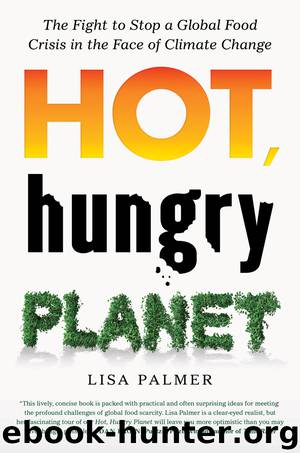Hot, Hungry Planet by Lisa Palmer

Author:Lisa Palmer
Language: eng
Format: epub
Publisher: St. Martin's Press
8
Rice
Knee-high weeds were growing in planter pots in a small room at a U.S. Department of Agriculture lab just outside Washington, D.C. Light, heat, and carbon dioxide reached the plants at steady levels. For more than a month the weeds survived in the same conditions expected to be Earth’s norm about thirty years from now—carbon dioxide levels equivalent to an urban traffic jam and temperatures tipping into the dangerous zone for the planet’s health.
You’d think any plant would choke, but these particular weeds—a wild plant called red rice—were thriving. Scientists in the United States are conducting intensive experiments to cross hardy weeds with food crops such as rice and wheat. Their goal is to make these staples more resilient as higher temperatures, drought, and elevated carbon dioxide levels pose new threats to the world’s food supply, even as we welcome 2.6 billion more people to the global population.
Breeding allows scientists to build desirable traits into crops and limit their vulnerability to pests and disease. Modern plant breeding techniques run a spectrum, from the classical to the computer enabled. Classical breeding is fairly straightforward; it deliberately interbreeds, or crosses, closely related plants or wild relatives. For instance, a lima bean that is resistant to powdery mildew may be crossed with a high-yielding but disease-susceptible bean, with the goal of introducing mildew resistance without losing productivity. In this chapter I will discuss some research that shows how new breeding solutions might help plants cope with the environmental stresses expected as a result of climate change.
Lewis Ziska, a plant physiologist with the USDA’s Agricultural Research Service, is primarily a weed man. Weeds beguile Ziska. They may be the largest single limitation to global crop yield, yet they also have traits that are useful to plant growth. Red rice, which is actually a wild grass and likes to compete with cultivated rice, can adapt to more carbon dioxide and heat by producing more stems and grain—red rice has 80 to 90 percent more seed than cultivated rice, which is grown specifically for human consumption.
Plant breeders and plant physiologists now are capitalizing on those traits and counting on all sources of genetic variation, including the weedy lines of rice, to improve productivity in cultivated crop varieties.
Plant physiologists like Ziska usually define weeds in two ways: “An unwanted or undesired plant species” and “early vegetation following soil disturbance.” Ziska thinks a third definition could be more suitable: the unloved flower. “A weed is a plant whose virtues have yet to be discovered,” he said, paraphrasing Emerson. Why weeds? When other plants are wilting at extremes of temperature and rainfall, weeds thrive. Ziska studies weeds for their redemptive qualities. His research in this area was bolstered on a sweltering day in an abandoned industrial lot in Baltimore, twenty-five miles from his USDA research center, where he observed weeds that were two to four times bigger than weeds growing on his rural test plot. The urban weeds prompted further research on weeds that could be valuable to raising crops in high-carbon, high-heat scenarios.
Download
This site does not store any files on its server. We only index and link to content provided by other sites. Please contact the content providers to delete copyright contents if any and email us, we'll remove relevant links or contents immediately.
The Secret History by Donna Tartt(18934)
The Social Justice Warrior Handbook by Lisa De Pasquale(12163)
Thirteen Reasons Why by Jay Asher(8832)
This Is How You Lose Her by Junot Diaz(6828)
Weapons of Math Destruction by Cathy O'Neil(6203)
Zero to One by Peter Thiel(5724)
Beartown by Fredrik Backman(5662)
The Myth of the Strong Leader by Archie Brown(5451)
The Fire Next Time by James Baldwin(5373)
How Democracies Die by Steven Levitsky & Daniel Ziblatt(5168)
Promise Me, Dad by Joe Biden(5109)
Stone's Rules by Roger Stone(5048)
A Higher Loyalty: Truth, Lies, and Leadership by James Comey(4901)
100 Deadly Skills by Clint Emerson(4872)
Rise and Kill First by Ronen Bergman(4735)
Secrecy World by Jake Bernstein(4696)
The David Icke Guide to the Global Conspiracy (and how to end it) by David Icke(4652)
The Farm by Tom Rob Smith(4462)
The Doomsday Machine by Daniel Ellsberg(4445)
